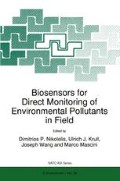Abstract
Biosensors for the detection of low levels of pesticides were prepared by entrapment of different enzymes in polyvinyl-alcohol bearing styryl pyridinium groups (PVA-SbQ). The inhibition of aldehyde dehydrogenase (EC 1.2.1.5), acetolactate synthase (EC 4.1.3.18) and acetyl cholinesterase (EC 3.1.1.7) allows respectively the detection of dithiocarbamate fungicides (10−8 M), sulfonylurea herbicides (10−6 M) and organophosphorus insecticides (10−7 M). The detection is amperometrically carried out.
Access this chapter
Tax calculation will be finalised at checkout
Purchases are for personal use only
Preview
Unable to display preview. Download preview PDF.
References
Rogers, K.R. (1995) Biosensors for environmental applications, Biosensors & Bioelectronics 10, 533–541.
Ortega, F., Bastide, J., and Hawkes, T.R. (1996) Comparison between thifensulfuron methyl-induced inactivation of barley acetohydroxyacid synthase and Escherichia coli acetohydroxyacid synthase isozyme II, Pestic. Biochem. Physiol. 56, 231–242.
Rouillon, R., Mestres, J.-J., and Marty, J.-L. (1995) Entrapment of chloroplasts and thylakoids in polyvinyl alcohol polymers. Optimization of membrane preparation and storage conditions, Anal. Chim. Acta 311, 437–442.
Iimes, J.R.M., Ulland, B.M., Valerio, M.G. (1969) Bioassay of pesticides and industrial chemicals for tumorigenicity in mice, J. Nath. Cancer Inst. 42, 1101–1114.
Seiler. J.Y.(I974) Ethylenethiourea (ETU)_ a carcinogenic and mutagenic metabolite of ethylenebisdithiocarbamate,.Nutat. Res. 26, I89–191.
Graham, S.L., Davis, K.J., Hansen W.H., and Graham, C H (1975) Effects of prolonged ethylenethiourea ingestion on the thyroid of the rat, Food Cosmetol. Toxicol. 13, 493–499.
Teramoto, S., Moriya, M., Kato, K., Tezuka, H., Nakamura, S., Shingu, A. and Shirasu, Y. (1977) Mutagenicity testing on ethylenethiourea, Mutat. Res. 56, 121–129.
Teramoto, S., Saito, R. and Shirasu, Y. (1980) Teratogenic effects of combined administration of ethylenethiourea and nitrate in mice, Teratology 21, 71–78.
Vincent, G. (1991) Organic pollutants in the aquatic environment, G. Angelotti and A. Bjorseth, Eds.,Kluwer Academic Publishers, Dordrecht, pp. 285–291.
Fielding, M., Barcelò, D., Helweg, A., Galassi, S., Torstensson, L., van Zoonen, P., Wolter, R., and Angeletti, G. (1992) Pesticides in Ground and Drinking Water (Water Pollution Research Report, 27),Commission of the European Communities, Brussels, pp. 1–136.
Horwitz, W. (Ed.). (1970)Association of Official Analytical Chemists, Official Methods ofAnalysis,11th ed, Washington, D.C, p. 118.
Keppel, G.E. (1971) Collaborative study of the determination of dithiocarbamate residues by a modified carbon disulfide evolution method, J. Assoc. Off Anal. Chem., 54, 528–532.
Jongen, M.J.M., Ravensberg, J.C., Engel, R., and Leenheers, L.H. (1991) Gas-liquid and liquid chromatographic determination of maneb for the assessment of occupational exposure in the production of ornamentals, J. Chrom. Sc., 29, 292–297.
Lehotay, J., and Kisovà, D. (1993) HPLC study of mancozeb degradation on leaves, J. Liq. Chromatogr. 16, 1015–1022.
Hakan Gustafsson, K., and Thompson, R.A. (1981) High-pressure liquid chromatographic determination of fungicidal dithiocarbamates, J. Agric. Food Chem. 29, 729–732.
Woodrow, J.E., Seiber, J.N., and Fitzell, D. (1995) Analytical method for the dithiocarbamate fungicides ziram and mancozeb in air: preliminary field results, J. Agric. Food Chem. 43, 1524–1529.
Wiegand-Rosinus, M., Obst, U., Haberer, K., and Wild, A. (1992) Enzymes in vitro as indicators for pesticides: an examination, Environ. Toxicol. Wat. Quality 7, 313–321.
Beyer, E.M., Duffy, M.J., Hay, J.V, and Schlueter, D.D. (1987) Herbicides: Chemistry, degradation, and mode of action, P.C. Kearney and D.D. Kaufman, Eds. M. Dekker, New York, pp 118–189.
LaRossa, R.A., Schloss, J.V. (1984) The sulfonylurea harbicide sulfometuron methyl is an extremely potent and selective inhibitor of acetolactate synthse in Salmonella typhimurium, J. Biol. Chem. 259, 8753–8757.
Abell, L.M., and Schloss, J.V. (1991) Oxygenase side reactions of acetolactate synthase and other carbanionforming enzymes, Biochem. 30, 7883–7887.
Muhitch, M.J., Shaner, D.L., Stidham, M.A. (1987) Imidazolinones and acetohydroxyacid synthase from higher plants, Plant Physiol. 83, 451–456.
Schloss, J.V. (1990) Acetolactate synthase, mechanism of action and its herbicide binding site, Pestic. Sci. 29, 283–292.
Eto, M. (1977) Organophosphorus Pesticides: Organic and Biological Chemistry, CRC Press, Cleveland, OH.
Minelli, E.V., Cabras, P., Angioni, A., Garau, V.L., Melis, M., Pirisi, F.M., Cabitza, F., and Cubeddu, M. (1996) Persistence and metabolism of fenthion in orange fruit, J. Agric. Food Chem. 44, 935–939.
Lacorte, S., and Barcelò, D. (1995) Determination of organophosphorus pesticides and their transformation products in river waters by automated on-line solid-phase extraction followed by thermospray liquid chromatography-mass spectrometry, J. Chromatogr. A712, 103–112.
Lentza-Rizos, Ch., Avramides, E.J., and Roberts, R.A. (1994) Persistence of fenthion residues in olive oil, Pestic. Sci., 40, 63–69.
Espinosa-Mansilla, A., Salinas, F., and Zamoro, A. (1994) Kinetic study of degradation of chlorpyrifos by using a stopped-flow FIA system. Semiautomatic determination in commercial formulations, Talanta 41, 651–657.
Lacorte, S., and Barcelò, D. (1994a) Validation of an automated precolumn exchange system (Prospekt) coupled to liquid chromatography with diode array detection. Application to the determination of pesticides in natural waters, Anal. Chim. Acta 296, 223–234.
Lacorte, S. and Barcelò, D. (1994b) Rapid degradation of fenitrothion in estuarine waters, Environ. Sci. Technol. 28, 1159–1163.
Lacorte, S., Ehresmann, N., and Barcelò, D. (1996) Persistence of temephos and its transformation products in rice crop field waters, Environ. Sci. Technol. 30, 917–923.
Bellar, T.A., and Budde, W.L. (1988) Determination of nonvolatile organic compounds in aqueous environmental samples using liquid chromatography/mass spectrometry, Anal. Chem. 60, 2076–2083.
Author information
Authors and Affiliations
Editor information
Editors and Affiliations
Rights and permissions
Copyright information
© 1998 Springer Science+Business Media Dordrecht
About this chapter
Cite this chapter
Marty, JL., Noguer, T., Seki, A., Jeanty, G. (1998). Enzyme Sensors for the Detection of Pesticide Families. In: Nikolelis, D.P., Krull, U.J., Wang, J., Mascini, M. (eds) Biosensors for Direct Monitoring of Environmental Pollutants in Field. NATO ASI Series, vol 38. Springer, Dordrecht. https://doi.org/10.1007/978-94-015-8973-4_16
Download citation
DOI: https://doi.org/10.1007/978-94-015-8973-4_16
Publisher Name: Springer, Dordrecht
Print ISBN: 978-90-481-4959-9
Online ISBN: 978-94-015-8973-4
eBook Packages: Springer Book Archive

